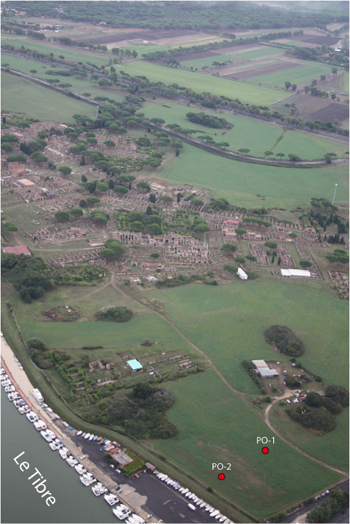

| Visitors Now: | |
| Total Visits: | |
| Total Stories: |

| Story Views | |
| Now: | |
| Last Hour: | |
| Last 24 Hours: | |
| Total: | |
Lost City Of Ostia Found, Ancient Harbor Supplied Rome With Wheat


Credit: © S. Keay
A French-Italian team led by Jean-Philippe Goiran, CNRS researcher, has tried to definitely verify the hypothetical location of the harbour, by using a new geological corer. This technology solves the problem of groundwater which makes this area rather difficult for archeologists to excavate beyond 2 m deep.

Two sediment cores have been extracted, showing a complete 12 m depth stratigraphy and the evolution of the harbour zone in 3 steps:
(2) 2- A middle layer, rich in grey silty-clay sediments, shows a typical harbour facies. According to calculations, the basin had a depth of 6.5 m at the beginning of its operation (dated between the 4th and 2d centuries BC). Previously considered as a river harbour that can only accommodate low draft boats, Ostia actually enjoyed a deep basin capable of receiving deep draft marine ships.
(3) 3 – Finally, the most recent stratum, composed of massive alluvium accumulations, shows the abandonment of the basin during the Roman imperial period. With radiocarbon dates, it is possible to deduce that a succession of major Tiber floods episodes of the Tiber finally came to seal the harbour of Ostia between the 2nd century BC and the 1st quarter of the 1st century AD (and this despite possible phases of dredging). At that time, the depth of the basin was less than 1 m and made any navigation impossible. It was then abandoned in favor of a new harbour complex built 3 km north of the Tiber mouth, called Portus. This alluvium layer fits with the geographer Strabo’s text (58 BC – 21/25 AD) who indicated the sealing of the harbour basin by sediments of the Tiber at that time (Geographica, 231-232).
The discovery of the river mouth harbour of Ostia, north of the city and west of the Imperial Palace, will help better understand the links between Ostia, its harbour and the ex-nihilo settling of Portus, initiated in 42 AD and completed in 64 AD under the reign of Nero. This gigantic 200 ha wide complex became the harbour of Rome and the largest ever built by the Romans in the Mediterranean.
Between the abandonment of the port of Ostia and the construction of Portus, researchers estimate that nearly 25 years have passed. Rome was the capital of the ancient Roman world and the first city to reach one million inhabitants. So how was it supplied with wheat during that period? The question arises now researchers.
(1) This work was also carried out in collaboration with the Maison Méditerranéenne des Sciences de l’Homme (CNRS / Aix-Marseille Université), the Universita Roma 3, the Institut Universitaire de France and received the support of the ANR (Agence Nationale de la Recherche).
Citation: J.-Ph. Goiran, F. Salomon, E. Pleuger, C. Vittori, I. Mazzini, G. Boetto, P. Arnaud, A. Pellegrino, décembre 2012, “Résultats préliminaires de la première campagne de carottages dans le port antique d’Ostie”, Chroniques des Mélanges de l’Ecole Française de Rome, vol. n°123-2.


